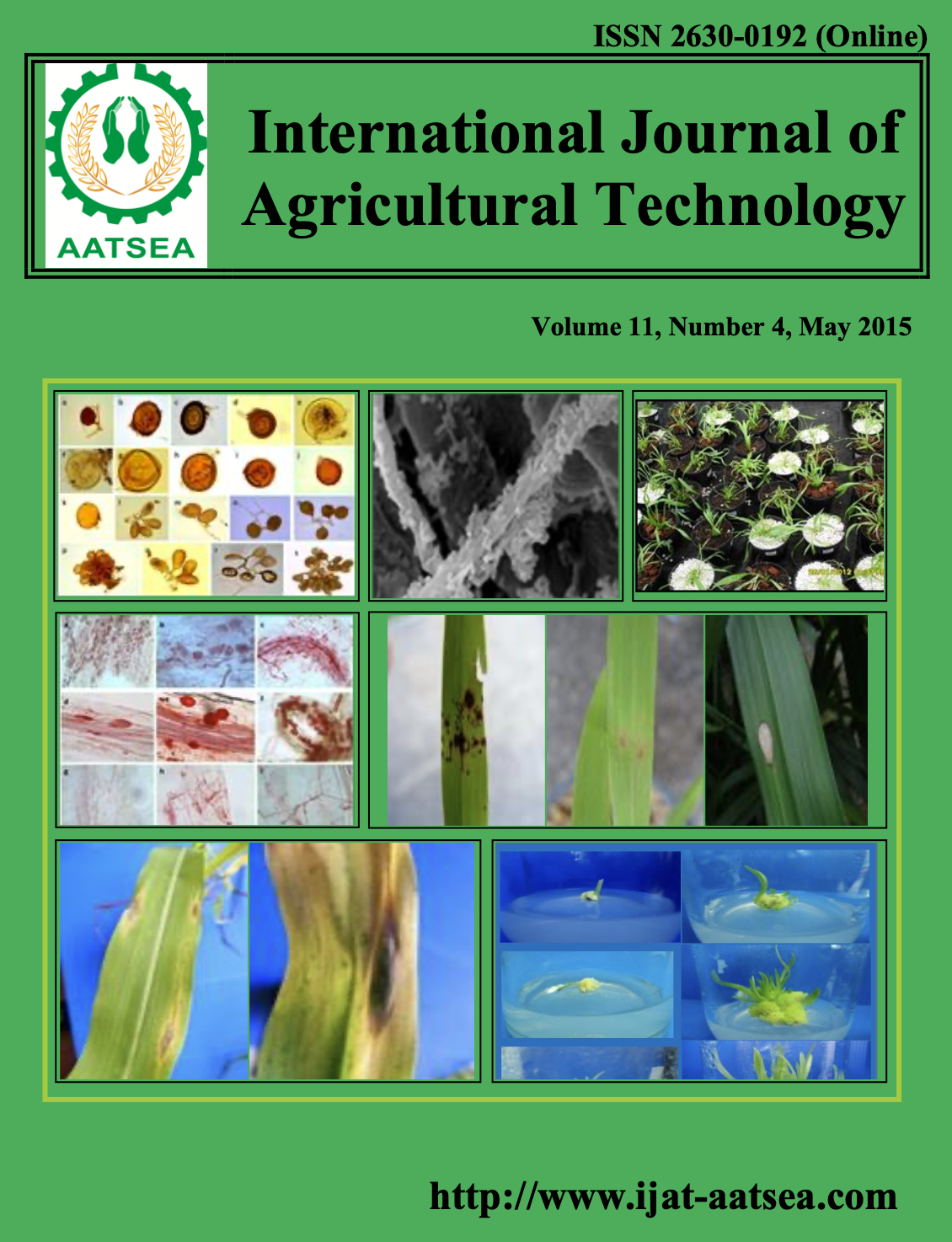Effect of Trichoderma harzianum against Thielaviopsis paradoxa and their pathological potential on date palm seedlings
Main Article Content
Abstract
isolates were varied of antagonistic properities toward T. paradoxa. Trichoderma harzianum (No. 1) was highly suprssed and showed over growth on T.paradoxa , meanwhile T. harzianum (No. 8) reduced linear growth of
T. paradoxa by 44 % and recorded high inhibition zone than the all Tricoderma isolates tested. Germinated seeds of date palm were soaking for 1 hour on T. harzianum isolate (No. 8) before, after and during inoculation by T. paradoxa. Different treatments of soaking date palm seeds on T. harazianum isolate (No.8)showed significantly reduced rot root of date palm seedlings than control. Germinated seeds of date palm were soaked with T. harzianum before inoculation of T. paradoxa gave more effective to reduce root rot of date palm seedlings than treatment after inoculation with pathogen. Germinated seeds of date palm were soaked with T. harzianum alone and followed by T. harzianum before inoculation with pathogen stimulated growth of date palm seedlings i.e., length and fresh weight of shoot and root systems. It was preliminary investigation on screening antagonistic biocontrol agents against fungal pathogen causing root rot disease of date palm.
Article Details

This work is licensed under a Creative Commons Attribution-NonCommercial-NoDerivatives 4.0 International License.
References
Arafat, K. H., Mohamad, A. M. and Elsharabasy, S. (2012). Biological control of date palm root-rots diseases using Egyptian isolates of Streptomyces. Research journal of agriculture and biological sciences 8:224-230.
Baraka, M. A., Radwan, M. and Arafat, K. H. (2011). Survey and identification of major fungi causing root rot on date palm and their relative importance in Egypt. Journal of Biodiversity and Environmental Sciences 6:319-337.
Barnett, H. L. and Hunter, B. B. (1998). Illustrated genera of imperfect fungi 4th edition. Minnesota, USA: APS Press. 218 pp.
Contreras-Cornejo, H. A., Macias-Rodriguez, L., Cortes-Penagos, C. and Lopez-Bucio, J. (2009). Trichoderma virens, a plant beneficial fungus, enhances biomass production and promotes lateral root growth through an auxin-dependent mechanism in Arabidopsis. Plant Physiology 149:1579-1592.
Druzhinina, I. S., Seidl-Seiboth, V., Herrera-Estrella, A., Horwitz, B. A., Kenerley, C. M., Monte, E., Mukherjee, P. K., Zeilinger, S., Grigoriev, I. V. and Kubicek, C. P. (2011). Trichoderma: the genomics of opportunistic success. Nature Reviews Microbiology 9:749-759.
El- Hassni, M., El-Hadrami, A., Daayf, F., Cherif, M., Baraka, E. A. and El-Hadrami, I. (2007). Biological control of bayoud disease in date palm: selection of microorganisms inhibiting the causal agent and inducing defense reaction. Environmental and Experimental Biology 59:224-234.
Eziashi, E. I., Omamor, I. B. and Odigie, E. E. (2007). Antagonism of Tricoderma viride and effect of extracted water soluble compounds from Tricoderma species and benlate solution on Ceratocystis paradoxa. African Journal of Biotechnology 6:388-392.
FAO (2009). Agriculture data. Rome. Italy: Food and Agriculture Organization of United Nation.
Farrag, E. S. and Abo-Eyousr, K. (2011). Occurrence of some fungal diseases on date palm trees in Upper Egypt and its control. Plant Pathology Journal 10:154-160.
Mastouri, F., Bjorkman, T. and Harman, G. E. (2012). Trichoderma harzianum enhances antioxidant defense of tomato seedlings and resistance to water deficit. Molecular Plant-Microbe Interactions Journal 25:1264-1271.
Molan, Y. Y., Al-Obeed, R. S., Harhash, M. M. and El-Husseini, S. (2004). Decline of date palm offshoots infected with Chalara paradoxa in Riyadh region. Journal of King Saud University 16:79-86.
Nawar, L. S., Ziedan, E. H. and Sahab, A. F. (2001). Increasing the efficacy Trichoderma harzianum as biocontol agent by slow release nitrogen fertilizers for wilt control of sunflower. Journal of Agricultura Science. Mansoura University 26:1989-2000.
Sanchez, V., Rebolledo, O., Picaso, R. M., Elizabeth Cardenas, E., Cordova1, J., Gonzalez1 and Samuels, G. J. (2007). In vitro antagonism of Thielaviopsis paradoxa by Trichoderma longibrachiatum. Mycopathologia 163:49-58.
Snedecor, G. W. and Cochran, W. G. (1980). Statistical Methods 7th edition. Ames, USA: Iowa State University Press.
Soytong, K., Pongak, W. and Kasiolam, H. (2005). Biological of Thielaviopsis bud rot of Hyophorbe lagenicaulis in the field. Journal of Agricultural Technology 1:235-245.
Vinale, F., Flematti, G., Sivasithamparam, K., Lorito, M., Marra, R., Skelton, B. W. and Ghisalberti, E. L. (2009). Harzianic acid, an antifungal and plant growth promoting metabolite from Trichoderma harzianum. Journal of Natural Products 72:2032-5.
Ziedan, E. H., Farrag, E. S. H. and Sahab, A. F. (2013). First record and preliminary evaluation of Mucor hiemalis as biocontrol agent on inflorescence brown rot incidence of date palm. Archives Phytopathology and Plant Protection 46:617-626.
Ziedan, E. H., Saad, M. and Farrag, E. S. (2005). Biological control of grapevine root-rot by antagonistic microorganisms. African Journal of Mycology and Biotechnology 13:19-36.
Ziedan, E. H., Farrag, E. S. and Saad, M. (2007). Evaluation of some fungi and bacteria as biological agents to Fusarium wilt of banana. Journal of Agricultura Science, Mansoura University 32:3423-3437.
Ziedan, E. H. and Elewa, I. S. (2000). Treatment of sesame transplants with Trichoderma spp. and chitosan as control measures against wilt disease (Fusarium oxysporum f. sp. sesami). Proceedings of the Egyptian Phytopathology Society, 9th Conference of Phytopathology, Giza, Egypt. pp. 199-209.


